Converting a garage into a kitchen requires careful planning and execution but can result in a stunning transformation that exceeds your expectations. With the right design ideas and professional guidance, what was once merely a storage space for your vehicles can now become the heart of your home, where family and friends gather to share meals and create cherished memories.
One of the most significant advantages of converting a garage into a kitchen is its ample Space. Garages are often larger than typical kitchens, providing the opportunity to incorporate spacious countertops, islands, and storage areas. This extra room allows for greater flexibility in design and functionality, enabling you to create a kitchen that suits your specific needs and preferences.
Another benefit of transforming your Garage into a kitchen is the possibility of natural light. Garages typically have windows or large garage doors, which can be modified to bring in natural sunlight and create a bright and airy atmosphere. With the right design choices, you can maximize natural light, reducing the need for artificial lighting during the day and enhancing the overall ambiance of the Space.
Assessing the Feasibility of Converting Your Garage into a Kitchen
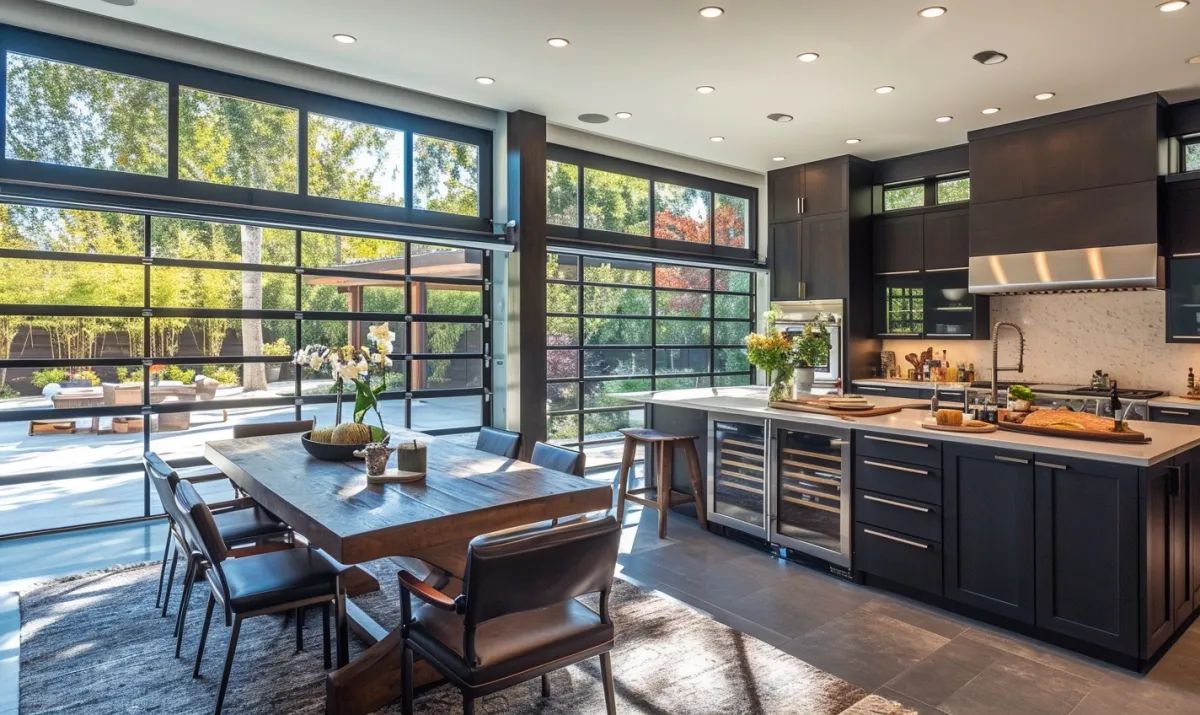
Are you considering converting your Garage into a kitchen? It can be an exciting and innovative way to expand your living space and create a functional and inviting area for cooking and entertaining. Before diving into this renovation project, it’s essential to assess the feasibility of the conversion. Here are some key factors to consider:
Layout and Space
The first thing to consider is whether your Garage has sufficient Space and the proper layout to accommodate a kitchen. Measure the area to accommodate the necessary appliances, cabinets, countertops, and dining space. Consider the shape of the Garage, obstacles like support columns, and the availability of natural light.
Structural Considerations
Look into the structural integrity of the Garage and assess whether any modifications are necessary to support the weight of kitchen appliances and additional fixtures. Hire a professional contractor or structural engineer to evaluate the foundation, walls, and roof to ensure they can handle the necessary modifications.
Permitting and Zoning Regulations
Before starting any renovation project, it’s essential to understand the legal and permitting requirements for converting your Garage into a kitchen. Check with your local building department to determine if you need permits, inspections, or approvals. You may need to comply with specific zoning regulations, setback requirements, or fire safety codes.
Plumbing and Electrical Considerations
Assess the proximity and accessibility of plumbing and electrical lines in your Garage. Converting your Garage into a kitchen will require running water supply lines, drain pipes, and electrical wiring for appliances, lighting, and outlets. Consult with a licensed plumber and electrician to determine the feasibility and cost of these installations.
Cost and Budget
Converting a garage into a kitchen can be a substantial investment. Consider the overall cost and your budget for the project. Account for expenses such as demolition, construction, materials, appliances, plumbing, electrical work, flooring, and kitchen fixtures. Obtain quotes from contractors and suppliers to help estimate the total cost.
By thoroughly evaluating the feasibility of converting your Garage into a kitchen, you can make an informed decision and plan accordingly. Remember to consult professionals for accurate assessments and guidance. Stay tuned for our upcoming blog posts, where we will delve into the legal and permitting requirements, design considerations, and other essential factors to consider when converting your Garage into a kitchen.
Understanding the Legal and Permitting Requirements for Garage Conversions
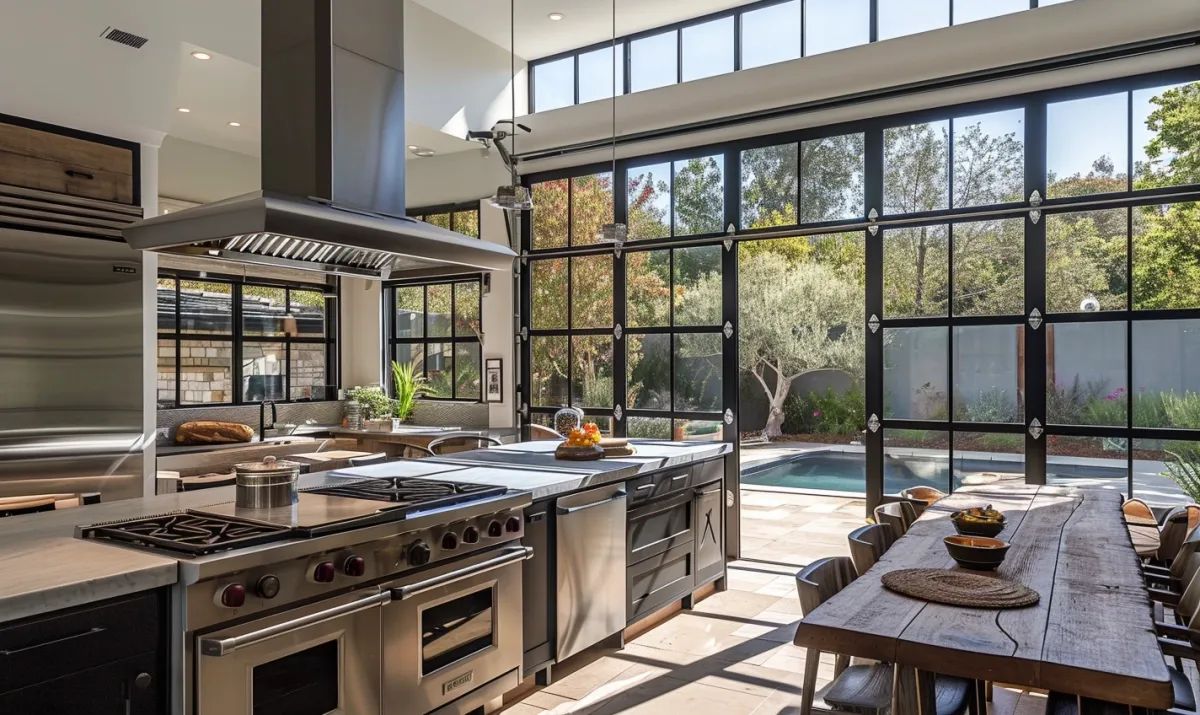
Converting a garage into a kitchen can be an exciting and practical project to expand your living space. However, before you embark on this journey, it’s crucial to understand the legal and permitting requirements involved. By familiarizing yourself with the necessary regulations, you can ensure a smooth and hassle-free conversion process.
Researching Local Regulations
Every locality has different regulations for converting a garage into a livable space. It’s essential to start by researching the specific requirements in your area, which may include zoning restrictions, building codes, and permits.
Here are a few key aspects to consider:
- Building Codes: Understand the building codes applicable to your area, as they provide regulations for structural integrity, electrical systems, plumbing, and fire safety.
- Zoning Restrictions: Check if your property is subject to any zoning restrictions that might limit or prohibit garage conversions for residential use.
- Permits: Determine the licenses you need to obtain before starting the project. Depending on your local requirements, this may include a building permit, plumbing permit, electrical permit, and potentially others,
Working with Professionals
Given the intricacies of legal and permitting requirements, it’s advisable to work with professionals who are knowledgeable in the field. Hiring an architect, contractor, or designer experienced with garage conversions can help you navigate the complex regulations and ensure that your project meets all necessary standards.
Obtaining the Required Permits
Once you clearly understand the local regulations and have hired professionals as needed, it’s time to start the permitting process. This typically involves submitting detailed plans and documentation to the relevant authorities for approval.
Here are some general steps to follow:
- Prepare Detailed Plans: Your architect or designer will create detailed plans, including floor plans, electrical layouts, plumbing systems, and any structural changes required.
- Submit Permit Application: Complete and submit the application with the necessary plans and supporting documents. Make sure to include any fees that might be required.
- Please wait for Approval: The permitting process may take some time, as the authorities will review your application and plan to ensure they comply with the regulations. It’s essential to be patient during this stage.
- Commence Construction: Once you receive the necessary permits, you can proceed with the conversion project, knowing you comply with all legal requirements.
By understanding the legal and permitting requirements for converting your Garage into a kitchen, you can ensure a successful transformation of your Space. Remember to research local regulations carefully, work with professionals, and obtain the necessary permits to create a functional and inviting kitchen that seamlessly integrates with the rest of your home.
Determining the Design and Layout for Your Garage Kitchen
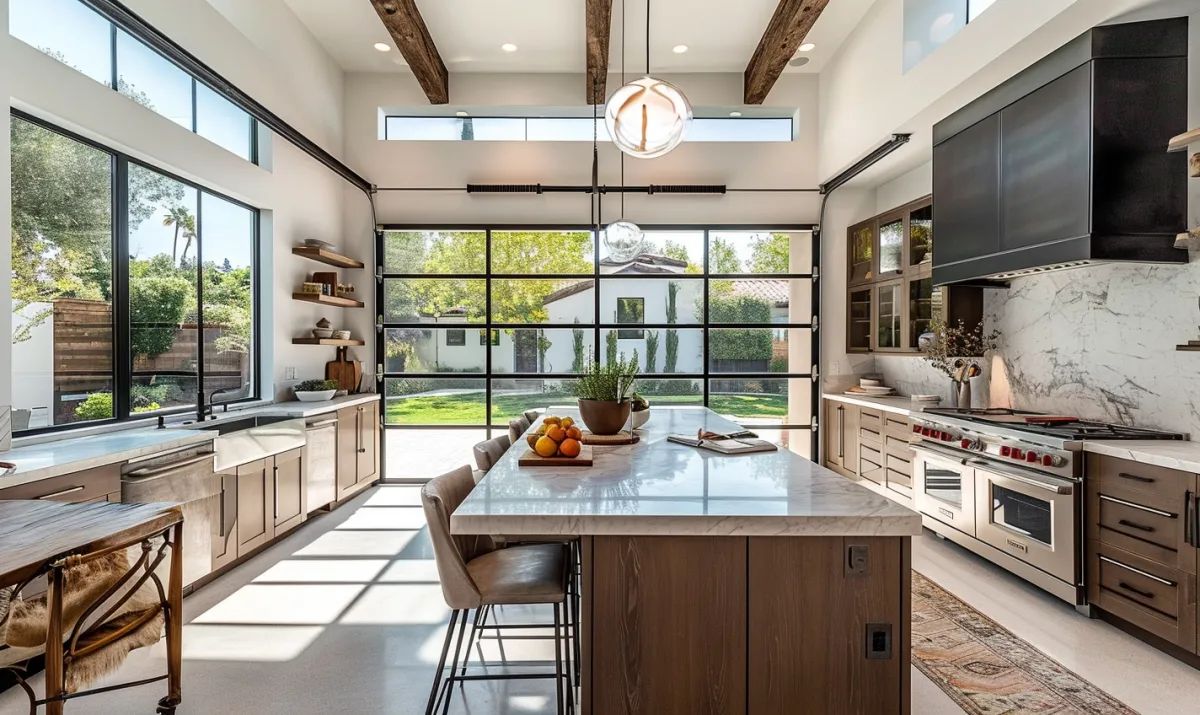
Now that you have assessed the feasibility of converting your Garage into a kitchen and familiarized yourself with the legal requirements, it’s time to dive into the exciting part: designing your garage kitchen. This is where your creativity can shine, and you can envision the perfect layout that suits your needs and preferences.
Evaluating the Space
Before settling on a design, look closer at your Garage to determine its strengths and limitations. Consider the following:
- Garage size and dimensions
- Existing features such as windows, doors, and electrical outlets
- Potential obstacles such as support columns or water heaters
- Accessibility to plumbing and electrical connections
Understanding these factors lets you decide where to place your kitchen appliances, cabinets, and workspaces.
The Work Triangle
When planning your garage kitchen layout, remember the “work triangle.” This refers to the efficient flow between the three main areas of a kitchen: the refrigerator, the sink, and the cooking area. A well-designed work triangle minimizes the distance and effort required to move between these essential components.
Consider the following tips for optimizing your work triangle:
- Place the refrigerator, sink, and stove in a triangular formation, with each side measuring between 4 and 9 feet
- Avoid any obstacles that could disrupt the flow, such as kitchen islands or large appliances
- Ensure ample countertop space near each element of the work triangle for food preparation
<h3.Style and Aesthetics
Your garage kitchen should reflect your taste and complement the overall design aesthetic of your home. Consider factors such as:
- Cabinet style and color
- Countertop materials
- Lighting fixtures
- Backsplash options
- Appliance finishes
By carefully selecting these elements, you can create a cohesive and visually appealing kitchen that seamlessly integrates into your home.
<h3.Finalizing Your Design
Once you have evaluated your Space, planned the layout with the work triangle in mind, and chosen your desired style and aesthetics, it’s time to finalize your garage kitchen design. Consider creating a detailed floor plan with measurements, annotations, and needed materials. This will guide your renovation project and help you stay organized as you bring your vision to life.
Remember, converting your Garage into a kitchen is an exciting opportunity to create a functional and inviting environment that enhances your home. By carefully considering the design and layout, you can ensure a successful transformation that meets your practical needs and aesthetic preferences.
Electrical and Plumbing Considerations for Garage Conversions
When converting a garage into a kitchen, addressing the electrical and plumbing requirements is crucial to ensure a safe and functional space. Here are some key considerations to keep in mind:
Electrical Considerations:
1. Assess the existing electrical system: Before beginning any work, have a licensed electrician inspect the Garage’s electrical system. They will evaluate its capacity and determine if any upgrades or modifications are necessary to accommodate kitchen appliances and lighting.
2. Install additional outlets: A kitchen requires numerous outlets to power appliances, small gadgets, and lighting. Plan for enough electrical outlets throughout the Space, adhering to local electrical codes.
3. Upgrade the electrical panel: If the existing electrical panel is outdated or insufficient, consider upgrading to one with a higher capacity to support the additional load. This will prevent electrical issues and potential hazards.
4. Consider dedicated circuits: Kitchen appliances such as ovens, refrigerators, and microwaves often require dedicated circuits to ensure they receive adequate power. Consult with an electrician to determine the specific requirements for each appliance.
Plumbing Considerations:
1. Assess plumbing accessibility: Determine whether the existing plumbing lines, including water supply and drainage, can be easily connected to the garage area. Plumbing accessibility can impact the placement and design of the kitchen elements.
2. Install plumbing fixtures: A functional kitchen requires a sink, dishwasher, and potentially a refrigerator with a water dispenser. Each of these fixtures will require proper plumbing connections. Consult a plumber to determine the best approach for incorporating these elements into your garage kitchen.
3. Consider water filtration systems: As you plan the plumbing for your garage kitchen, consider incorporating a water filtration system. This will ensure you and your family access to clean and healthy drinking water.
4. Hire a professional plumber: When it comes to plumbing work, hiring a licensed plumber who can navigate the complexities of connecting the kitchen fixtures and ensuring proper drainage is essential. They will ensure compliance with local plumbing codes and regulations.
Remember, tackling electrical and plumbing considerations for a garage conversion requires expertise and knowledge. It’s always best to consult professionals to ensure a safe and functional kitchen space. By addressing these considerations, you’ll be well on transforming your Garage into a beautiful and functional kitchen.
Insulating and Ventilating Your Garage-Turned Kitchen
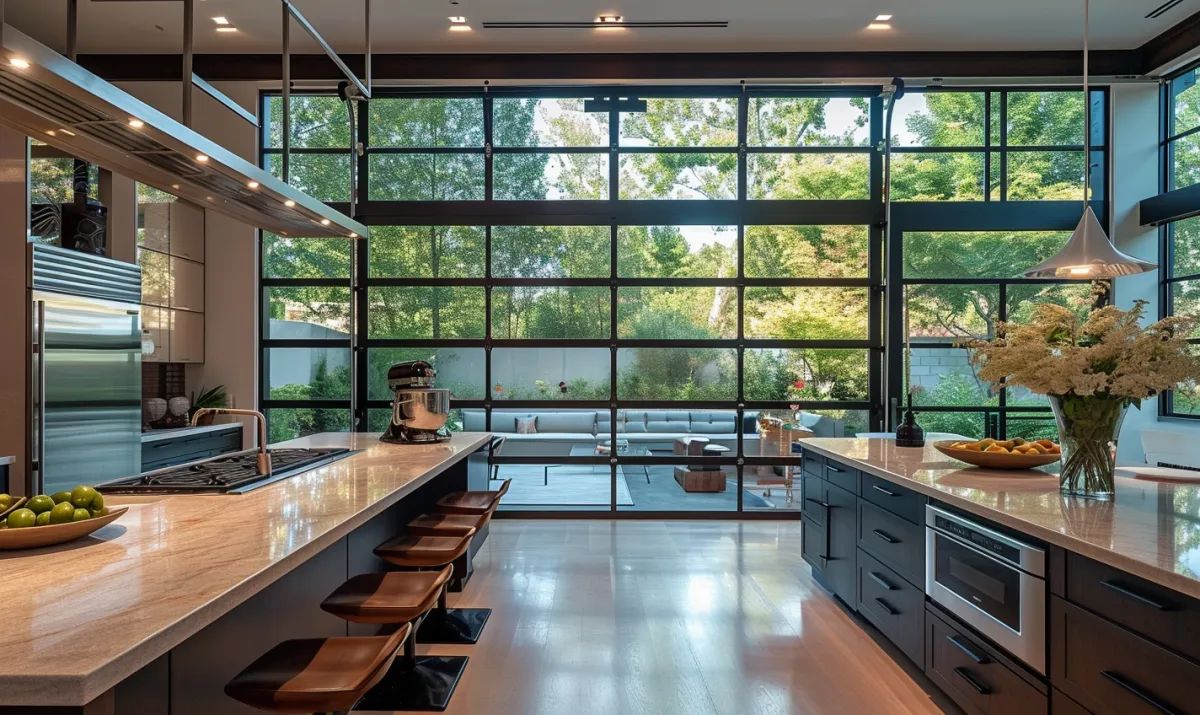
When converting your Garage into a kitchen, ensuring that the Space is well-insulated and adequately ventilated is crucial. These two factors play a significant role in creating a comfortable and functional environment for your new kitchen. Here’s what you need to know:
Why Insulation Matters
Insulation helps regulate the temperature within your garage kitchen, making it more energy-efficient and preventing any unwanted heat loss or gain. By insulating the walls, ceiling, and floor, you can create a comfortable space throughout the year, regardless of the weather outside. Insulation also aids in soundproofing, minimizing any noise disturbances from the outside, making your kitchen a peaceful haven.
Types of Insulation
There are various options for insulating your garage kitchen, but the most common ones are:
- Spray foam insulation provides excellent insulation properties and can be applied to any surface, including awkward nooks and crannies.
- Fiberglass insulation: A cost-effective option that is easy to install, fiberglass insulation comes in rolls or batts.
- Reflective insulation: This type reflects heat and prevents radiant heat transfer.
The Importance of Ventilation
Proper ventilation is essential in any kitchen to remove excess moisture, odors, and pollutants. It becomes even more critical in a garage kitchen conversion because garages typically lack windows and natural ventilation sources. Without proper ventilation, the air quality in your kitchen could be compromised, leading to mold and mildew growth.
Ventilation Options
Consider the following ventilation options for your Garage turned kitchen:
- Range hood: Install a range hood above your stove to capture and remove cooking fumes and odors.
- Extractor fan: Place an extractor fan in the ceiling or wall to ensure a constant fresh air flow, removing any excess moisture or pollutants.
- Windows or skylights: If possible, add windows or skylights to allow natural ventilation and introduce more natural light into the Space.
Remember, proper insulation and ventilation work hand-in-hand to create a comfortable and healthy environment in your garage kitchen conversion. Don’t overlook these crucial elements when planning your project.
Flooring Options for a Garage Kitchen Conversion
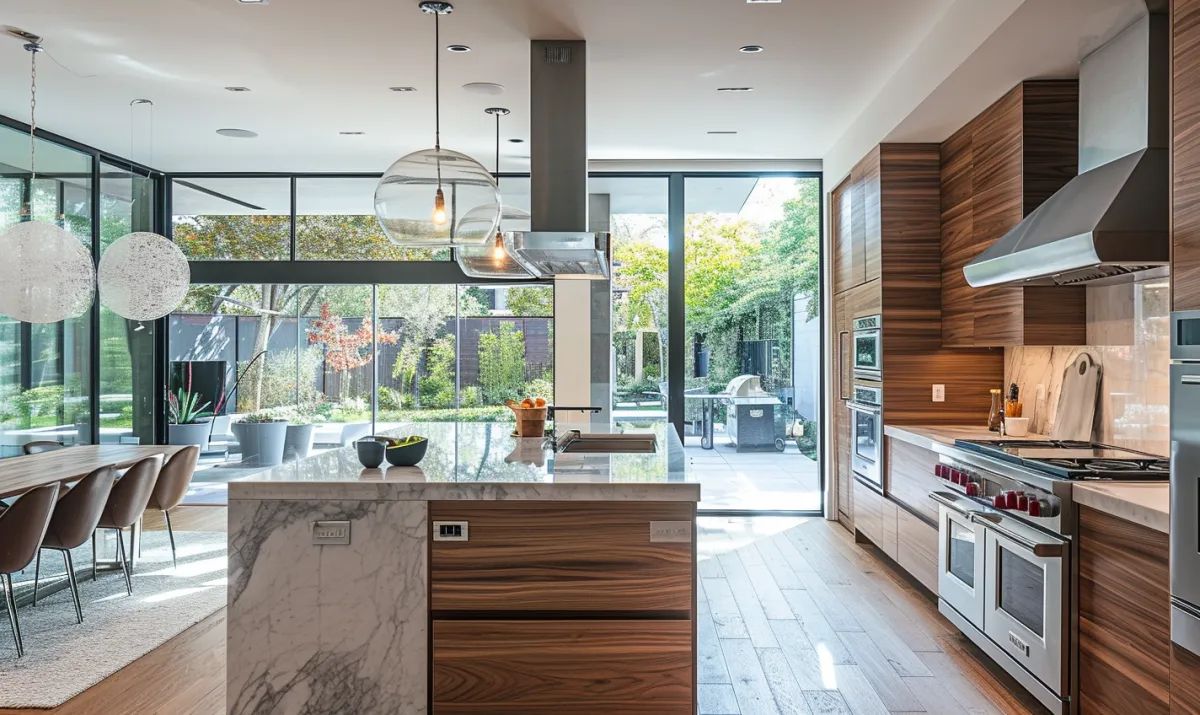
When converting a garage into a kitchen, choosing the right flooring is one important consideration. Since the garage floor was initially designed for parking vehicles and storage, it may not be suitable for a kitchen environment. Here are some flooring options to consider for your garage kitchen conversion:
1. Concrete Stain or Epoxy Coatings
If you want to maintain the industrial look of your Garage while enhancing its durability, concrete stain or epoxy coatings are excellent options. These coatings can be applied directly to the concrete floor, providing a seamless and easy-to-clean surface. Concrete stain adds a touch of color, while epoxy coatings offer a high-gloss finish that resists stains and spills.
2. Luxury Vinyl Planks (LVP)
Luxury vinyl planks (LVP) are a versatile and affordable flooring option for garage kitchen conversions. They come in various designs and mimic the look of hardwood, stone, or tile. LVP is water-resistant, easy to clean, and comfortable underfoot, making it an excellent choice for a kitchen. It also provides insulation against cold floors.
3. Tile
If you prefer a classic and timeless look, tile is a popular choice for kitchen flooring. Porcelain or ceramic tiles are durable, water-resistant, and easy to clean. They come in various styles, colors, and textures, allowing you to create a customized look for your garage kitchen.
4. Engineered Wood
Consider engineered wood if you want the warmth and beauty of hardwood flooring in your garage kitchen. Engineered wood is more resistant to temperature and moisture fluctuations than solid wood, making it a suitable option for a garage conversion. It can be installed as a floating floor, allowing easy removal and replacement.
5. Laminate
Laminate flooring is a budget-friendly option that offers durability and a variety of designs. It consists of multiple layers, including a photographic layer that can mimic the look of wood, stone, or tile. Laminate is easy to clean and maintain, making it a practical choice for a kitchen.
Remember, when choosing the flooring for your garage kitchen conversion, consider factors such as durability, water resistance, ease of maintenance, and style preferences. Each option has advantages, so weigh them against your needs and budget.
By selecting the right flooring, you can transform your home into a fully functional kitchen and create a welcoming, stylish space for cooking and gathering with family and friends.
Choosing the Right Cabinets, Countertops, and Appliances for Your Garage Kitchen
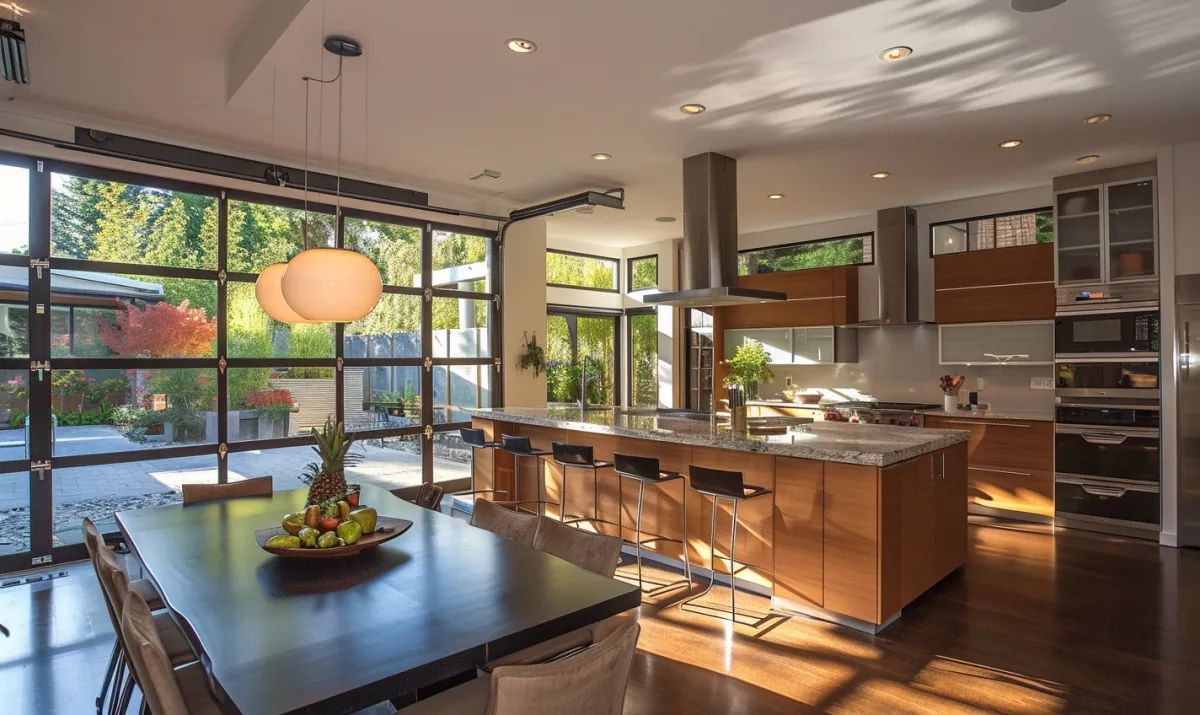
Now that you have decided to convert your Garage into a kitchen, it’s time to explore the various elements that will make this Space functional and aesthetically pleasing. Choosing suitable cabinets, countertops, and appliances is a crucial step in creating a garage kitchen that is both practical and visually appealing. Let’s dive in and discover how to make the best choices for your new culinary haven.
Cabinets:
Cabinets are essential for storage and play a significant role in defining the overall style of your garage kitchen. When selecting cabinets, consider the following:
- Measurements: Take accurate measurements of your garage space to ensure your chosen cabinets will fit perfectly.
- Material: Opt for durable and moisture-resistant materials, such as solid wood or marine-grade plywood, to withstand the changing conditions in a garage.
- Style: Choose a style that complements your desired kitchen aesthetic. Pick cabinets that blend seamlessly with your vision, whether sleek and modern or rustic and traditional.
Countertops:
Countertops not only provide a workspace but also serve as a focal point in your kitchen. Here are some factors to consider when choosing your countertops:
- Material: Select a material that suits your needs and personal preferences. Various materials are available, from natural stones like granite or marble to engineered options like quartz.
- Durability: Since a garage kitchen may be subjected to more wear and tear, opt for durable countertops that can withstand heavy use and resist stains and heat.
- Maintenance: Consider the level of maintenance required for each material. Some countertops may need regular sealing or cleaning, while others are more low-maintenance.
Appliances:
Having the right appliances can make all the difference in the functionality of your garage kitchen. When selecting appliances, keep the following points in mind:
- Size: Ensure that the appliances you choose fit well within the available Space in your Garage and do not overwhelm the overall layout.
- Energy Efficiency: Consider energy-efficient appliances to reduce utility costs and your environmental footprint.
- Features: Determine which features are essential to you. Whether it’s a top-of-the-line oven or a smart refrigerator, prioritize the functionalities that align with your cooking style and needs.
By carefully considering these aspects when choosing cabinets, countertops, and appliances, you can create a garage kitchen that meets your practical needs and reflects your style. Remember, it’s your Space to customize and make your own. Happy designing!
Optimizing Storage Solutions in Your Garage Kitchen
When converting a garage into a kitchen, one of the critical considerations is maximizing storage space. A well-organized kitchen not only makes cooking more accessible but also enhances the overall functionality and efficiency of the Space. Here are some tips to optimize storage solutions in your garage kitchen:
1. Utilize Vertical Space
Make the most of your garage kitchen’s height by installing tall rereachingiling cabinets. This provides ample storage for those items you only use occasionally. Consider using adjustable shelves or pull-out drawers to maximize accessibility and ease of use.
2. Install Pantry Cabinets
Pantry cabinets are a great addition to any kitchen, mainly if you have limited storage options. Convert a portion of your Garage into a walk-in pantry or add standalone pantry cabinets. These cabinets offer plenty of Space for storing dry goods, canned goods, and other pantry essentials.
3. Incorporate Smart Storage Solutions
Consider incorporating innovative storage solutions such as pull-out spice racks, corner cabinets with lazy susans, or deep drawers with dividers for pots and pans. These features optimize storage capacity while keeping everything within reach and neatly organized.
4. Utilize Wasted Space
Maximize the storage potential of every nook and cranny in your garage kitchen. Utilize the Space above your refrigerator or kitchen cabinets for storing items that are not frequently used. Install hooks or hanging racks to keep cooking utensils, mugs, or towels easily accessible.
5. Utilize Multi-Functional Furniture
Consider investing in multi-functional furniture to further optimize garage kitchen storage for kitchen islands or tables with built-in shelves or drawers to store extra cookware or utensils. This not only adds storage capacity but also enhances the functionality and versatility of your kitchen space.
6. Label and Organize
Efficient storage relies on proper organization. Use clear containers and labels to keep items neatly sorted and easily identifiable. Group similar items together, such as baking supplies or canned goods, to streamline your cooking and meal preparation process.
By implementing these storage optimization strategies, you can transform your Garage into a functional and efficient kitchen space. Not only will you have ample storage for all your kitchen essentials, but you’ll also enjoy a well-organized and visually pleasing environment that makes cooking a joy.
Enhancing Natural Light and Artificial Lighting in Your Garage Kitchen
A critical aspect of the tin kitchen is the lighting. Additionally, one essential thing can make a significant difference in the functionality and ambiance of your new Space. Here are some tips on enhancing both natural light and artificial lighting in your garage kitchen:
1. Utilize Natural Light
Introducing natural light into your garage kitchen can create a warm and inviting atmosphere. Consider these options:
- We are installing large windows or skylights to maximize the entrance of natural light.
- Adding doors leading to an outdoor patio or backyard allows light to flow in.
- I use colored curtains or blinds that can be easily opened or closed to control the amount of natural light.
2. Opt for Proper Artificial Lighting
While natural light is beneficial, it’s essential to have adequate artificial lighting to ensure functionality during the evening or on cloudy days. Here’s what you can do:
- Plan your lighting fixtures strategically, considering the different areas of your kitchen, such as overhead lights for general illumination, under-cabinet lighting for task-oriented spaces, and pendant lights for dining or island areas.
- Choose energy-efficient LED lighting options that not only brighten up your Space but also save on electricity costs.
3. Consider Lighting Control Systems
Investing in lighting control systems can add convenience and flexibility to your garage kitchen. These systems allow you to adjust your lights’ intensity and color temperature, creating various moods and settings. Some lighting control systems can be operated remotely from your smartphone or integrated with voice-controlled assistants like Alexa or Google Home.
4. Add Mirrors to Enhance Light Reflection
Strategically placing mirrors in your garage kitchen can amplify the natural light and make the Space appear larger. You can choose mirrored backsplashes, large mirror panels, or even mirrored cabinet doors to reflect light around the room.
5. Consider Dimmers for Ambiance
Consider installing dimmer switches for your lights to create a cozy and inviting atmosphere. Dimmers allow you to adjust the brightness of your artificial lighting according to different occasions and desired moods.
Combining natural light with well-planned artificial lighting allows you to create a well-lit and functional garage kitchen that meets your needs and enhances your cooking experience. These lighting enhancements can transform your Garage into a space that feels like a natural extension of your home.
Creating a Seamless Transition between the Garage and the Rest of Your Home
When converting a garage into a kitchen, one of the critical considerations is a seamless transition between the newly transformed Space and the rest of your home. By carefully planning and coordinating various design elements, you can ensure that your garage-turned-kitchen seamlessly blends with the overall aesthetic of your Living Space. Here are some tips to achieve a smooth transition:
1. Consistent Flooring:
Consider extending the same flooring from your existing home into the garage kitchen. This will create visual continuity and eliminate any jarring differences between rooms. Whether you have hardwood, tile, or laminate, extending the flooring into the Garage can make the Space feel like a space mural extension of your home.
2. Matching Cabinets and Countertops:
Choose kitchen cabinets and countertops that align with the style and materials used in the rest of your home. This could mean matching the wood finish, color palette, or hardware. By using consistent design elements, you can ensure a cohesive look throughout your living Space.
3. Lighting Consistency:
To maintain a seamless flow, it’s essential to consider lighting. Coordinate the lighting fixtures and styles used in your garage kitchen with those in the adjacent rooms or spaces. Consistency in lighting design will help create a sense of harmony and continuity between the different areas of your home.
4. Open Concept Layout:
Consider an open-concept design allowing easy sightlines from the kitchen to the adjoining rooms if possible. Removing walls or creating large openings can promote a sense of openness and connection, making the transition between spaces more fluid.
5. Decorative Accents:
Use decorative accents such as artwork, mirrors, or wall treatments to tie the garage kitchen design to the rest of your home. Similar colors or patterns in both areas can help create a cohesive look and feel.
Remember, the goal is to create a harmonious flow that seamlessly integrates your newly converted kitchen with the rest of your home. By carefully considering elements such as flooring, cabinets, lighting, layout, and decorative accents, you can achieve a smooth transition that enhances the functionality of your Living Space.
Incorporating Functional and Aesthetically Pleasing Elements in Your Garage Kitchen
Now that you’ve tackled the legalities, design, layout, and various considerations for converting your Garage into a kitchen, it’s time to focus on incorporating functional and aesthetically pleasing elements to make your garage kitchen shine. Here are some tips to help you create a space that is both practical and visually appealing:
1. Quality Materials and Finishes
Invest in high-quality materials and finishes that can withstand the wear and tear of a kitchen environment. Opt for durable countertops, such as quartz or granite, and choose flooring options that are easy to clean and maintain, like porcelain tiles or vinyl planks.
2. Ample Storage Solutions
Maximize your storage space with clever organization systems. Consider installing customized cabinetry with plenty of storage for pots, pans, utensils, and pantry items. Pull-out shelves, lazy Susans, and dividers can help you make the most of every inch of available Space.
3. Smart Appliances
Choose energy-efficient appliances that function well and add a modern touch to your garage kitchen. Stainless steel appliances are famous for their sleek and professional look. Consider investing in smart appliances that offer advanced features and can be controlled remotely for added convenience.
4. Stylish Lighting
Proper lighting is essential; your garage kitchen is no exception. Incorporate a combination of task, ambient, and accent lighting to create a warm and inviting atmosphere. Pendant lights above the island or breakfast bar can be a focal point while providing adequate task lighting.
5. Decorative Elements
Add personal touches to your garage kitchen to make it feel like a valid extension of your home. Hang artwork or display decorative items that complement the overall style and color scheme. Consider incorporating plants or fresh herbs for a touch of greenery and a refreshing atmosphere.
Remember, converting a garage into a kitchen requires careful planning and attention to detail. By incorporating functional and aesthetically pleasing elements, you can create a space that meets your cooking needs and enhances your home’s overall look and feel. With the right design choices, your garage kitchen can become the heart of your household, serving as a gathering place for family and friends to enjoy delicious meals and create lasting memories.
Transforming Your Garage Kitchen into a Functional and Inviting Space
So, you’ve decided to convert your Garage into a kitchen. Congratulations! This exciting endeavor will add value to your home and create a functional and inviting space for cooking and entertaining. However, transforming a garage into a kitchen requires careful planning and execution to ensure a successful result. Here are some key factors to consider:
1. Maximizing Space
Garages are often spacious, providing ample room to create a kitchen that meets your needs. Carefully consider your kitchen’s layout and functionality, ensuring enough Space for appliances, cabinets, countertops, and a comfortable dining area.
2. Efficient Plumbing and Electrical Work
You’ll need to hire professionals to handle the plumbing and electrical work required for your garage kitchen conversion. This includes installing new water lines, drains, and electrical outlets to accommodate kitchen appliances and fixtures. Consult a licensed plumber and electrician to ensure all work meets local building codes and regulations.
3. Ventilation and Insulation
Proper insulation and ventilation are essential to create a comfortable and energy-efficient kitchen. Insulate the walls and ceiling to regulate temperature and reduce noise levels. Install a ventilation system, such as an exhaust fan or range hood, to remove cooking odors, smoke, and excess heat from the kitchen.
4. Functional Storage Solutions
To make the most of your garage kitchen, incorporate intelligent storage solutions. Consider installing built-in cabinets, pantry shelves, and a spacious island with drawers and cabinets. Utilize vertical Space by adding hooks or racks to hang pots, pans, and utensils, maximizing storage capacity while keeping everything within easy reach.
5. Stylish Design and Decor
Transforming your Garage into a kitchen doesn’t mean sacrificing style and aesthetics. Choose a design theme that complements the rest of your home while reflecting your taste. Select attractive countertops, cabinets, backsplashes, and flooring materials that are durable and easy to maintain. Add personal touches through decorative elements like artwork, lighting fixtures, and colorful accents.
Converting your Garage into a kitchen requires careful consideration of various factors, from space optimization planning to execution. By correctly planning and executing the conversion, you can transform your Garage into a functional and inviting kitchen that will be the heart of your home.
Conclusion
Converting a Garage into a Kitchen – A Stunning Transformation
Transforming a garage into a kitchen is a bold and exciting project that can completely revolutionize how you use your home. The possibilities are endless for creating a functional and aesthetically pleasing space that serves as a kitchen and becomes the heart of your home. With careful planning and consideration, you can turn a dull and unused garage into a stunning kitchen for you and your family.
Repurposing your Garage can increase your property’s value and gain valuable square footage. The flexibility of a garage conversion allows you to customize your kitchen according to your unique needs and style. Whether you dream of a modern, sleek design or a cozy and traditional space, converting a garage provides the perfect opportunity to bring your vision to life.
One of the critical advantages of converting a garage into a kitchen is the abundance of Space. Garages typically offer more room than a conventional kitchen, allowing for larger kitchen islands, additional storage, and even Space for a dining area or breakfast nook. This extra Space enhances your kitchen’s functionality and creates a welcoming and comfortable environment for gatherings with family and friends.
In conclusion, converting a garage into a kitchen is a remarkable transformation that can bring countless benefits to your home. The possibilities are endless, from increasing property value to creating a unique and personalized space. So, suppose you’re looking to embark on a home improvement project to enhance your living space and add value to your property; consider converting your Garage into a kitchen. In that case, it’s a decision you won’t regret.
Frequently Asked Questions (FAQs)
Frequently Asked Questions about Converting a Garage into a Kitchen
Q: Is converting a garage into a kitchen a good idea?
A: Converting a garage into a kitchen can be a great idea if you need additional Space for your home and want to increase its value. It offers flexibility and can give you the kitchen of your dreams without expensive renovations.
Q: What are the benefits of converting a garage into a kitchen?
A: Converting a garage into a kitchen provides more usable Space, adds value to your home, and allows for customization. It also eliminates the need for costly construction work, as the Garage already has a sturdy structure and utilities.
Q: What factors should I consider before converting my Garage into a kitchen?
A: Some important factors to consider include obtaining necessary permits, assessing the structural integrity of the Garage, evaluating the ventilation and insulation requirements, and planning for plumbing and electrical work. It’s essential to consult with professionals and create a detailed budget and timeline for the project.
Q: How can I ensure my converted Garage meets building codes and regulations?
A: To ensure compliance with building codes and regulations, working with a licensed contractor experienced in garage conversions is crucial. They will guide you through the permit process and ensure the construction meets all safety and regulatory standards.
Q: How much does converting a garage into a kitchen cost?
A: The cost of converting a garage into a kitchen can vary depending on various factors, such as the size of the Garage, the quality of materials used, the extent of electrical and plumbing work required, and the location. It’s best to consult with professionals for an accurate cost estimate.
Q: How long does converting a garage into a kitchen take?
A: The duration of a garage conversion project depends on the complexity of the renovation, the Garage’s size, and unforeseen circumstances that may arise. Generally, the process can take a few weeks to several months.